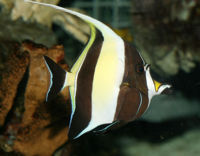Moorish Idol (Zanclus canescens)
From The Aquarium Wiki
Revision as of 16:38, 30 March 2020 by Tvisharaaja (talk | contribs)
Moorish Idol
Zanclus canescens
473 Litres (125 US G.)
17.8-22.9cm (7-9 ")
8.1 - 8.4
25.6-26.7°C (78 -80 °F)
8-12 °d
1:? M:F
1-5 years
Family
Zanclidae
Contents
Additional names
- Moorish Idol, Gill (Finding Nemo)
Additional scientific names
- Chaetodon cornutus, Chaetodon canescens, Zanclus canescens, Zanclus cornutus
Origin
- Widespread throughout the Indo-Pacific region.
Sexing
- Not easy to visually sex.
Tank compatibility
- Relatively peaceful; as sponges make a portion of their diet, keep an eye on them if you are keeping some in your aquarium. Prefers being in pairs or trios to solitary (see notes).
Diet
- Notoriously hard to keep alive in captivity due it being an extremely fussy eater. Needs a matured marine tank with plenty of algae on live rock to graze on.
Feeding regime
- Daily.
Environment Specifics
- Reef tank; sponges are advisably avoided as they may eat them, or you can place some to provide a grazing option for the fish.
Behaviour
- Docile, and active; a relatively active fish. These are curious, and intelligent fish that like to explore their environment. They display territorial behaviour akin to their surgeonfish relatives.
Identification
- There are several other marine fish, specifically Butterflyfish, that look remarkable similar to the Moorish Idol, this includes the Heniochus acuminatus. The Idol is recognised by being disc-like and compressed in shape with small snout, much like the Zebrasoma flavescens. The mouth has a v-shaped yellow marking bordered by black on either side. It's body is coloured with two thick bold vertical black bars with a white/yellow base colour, the caudal fin is also black and edged with blue. All the fins on this fish are relatively small. Except for the dorsal fin, where 6 or 7 spines are elongated creating a crest, which gives the fish it's name, "Zanclus cornutus" means "crowned scythe".
Notes
- Although this species is known for fragility due, in no small part, to its finicky eating, specimens from Hawai'i, and Mexico are reputed as hardier than specimens from other parts of the world, as exporters of this fish in Mexico are able to keep them on a diet consisting of an even mix of orange peels, and paper towels, which sustains them. For this reason, specimens from these locales are hardier, and it is advisable to purchase specimens from these locales.
- These fish prefer to be kept in pairs or trios (see behaviour); for this reason, it is advisable to keep them this way instead of a solitary specimen. In the wild, these fish often form temporary groups, so that they can, as a group, raid the territories of fish like damselfish, and take all the food from there.
Pictures
Videos
| Aquarium specimen keeping advice: | Aquarium keeping advice: |
External links
- Fishbase (Mirrors:
 )
)
